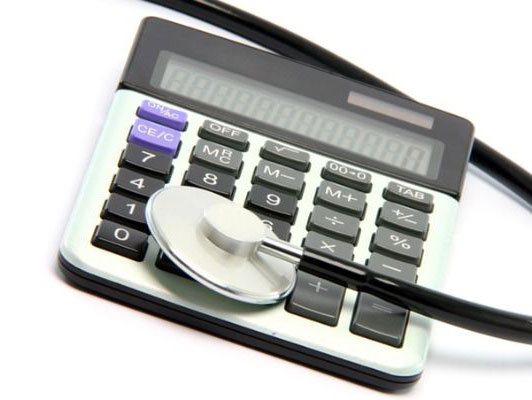
|
Calculator Library |

|
||
| Home » 87 Calculators » Blog » How Do Calculators Work? | ||||
HOW DO CALCULATORS WORK?
These ubiquitous tools can be small, portable devices carried in a pocket or purse or larger, more complex machines used in scientific and engineering applications. Regardless of their size and intended use, all calculators rely on a few basic principles to function. In this article, we'll take a closer look at the inner workings of calculators, exploring the technology and algorithms that make them such powerful tools for performing mathematical calculations. To understand how calculators work, we first need to understand the basic principles of arithmetic. At its core, arithmetic is the study of quantities and how they relate to each other. This involves performing operations such as addition, subtraction, multiplication and division of numbers to solve mathematical problems. At their most basic, calculators operate using a series of circuits and chips designed to perform these mathematical operations. Operations can be simple, like basic arithmetic, or more complex, like square roots and trigonometric functions. The circuits and chips in a calculator are connected to a series of buttons or keys that allow the user to enter the numbers and operations they want to perform. When a button is pressed, it sends a signal to the calculator's circuits and chips, which then carry out the corresponding operation. To perform these operations, calculators use a variety of algorithms, which are sets of step-by-step instructions for solving a particular problem. For example, when performing multiplication, a calculator uses an algorithm known as the "multiplication algorithm" to compute the product of two numbers. At a high level, calculators work by taking input from the user in the form of numbers and mathematical operations and then using this input to perform calculations and provide an output. This process is made possible by a combination of hardware and software components that work together to interpret the user's input, perform the necessary calculations and display the results. Hardware Components
When a user enters a mathematical expression into a calculator, such as "2 + 3" or "5 x 6", the calculator's central processing unit, also known as the "CPU" or processor, uses its program to interpret the expression and perform the necessary calculations. This process involves breaking down the expression into its individual components, such as the numbers and the operation and then using the appropriate algorithms to perform the calculations. This process is explained in more detail below. The processor is the "brain" of the calculator. It's responsible for executing the instructions stored in the calculator's software and performing the necessary calculations. The processor is typically a microprocessor, a tiny, highly-integrated chip containing millions of transistors. Transistors are tiny electronic switches that can be turned on or off to represent the ones and zeros of digital information. These transistors store and manipulate data, allowing the processor to perform the complex calculations required for arithmetic operations. The processor is controlled by a program, which is a set of instructions telling the processor what to do. This program is typically stored in the calculator's memory, a small amount of storage space that the calculator uses to hold data and instructions. Memory is used to store data and intermediate results as it performs calculations. Some calculators have a small amount of memory. In contrast, others have more complex memory systems that allow for the storage of more data and the ability to perform more complex calculations. Once the calculations are complete, the calculator displays the result on its screen, also known as the "display". This is typically done using a display driver, a specialized chip that translates the digital data from the processor into the images and text displayed on the calculator's screen. The most common type of display used in calculators is a liquid crystal display (LCD), which uses a grid of pixels to show numbers and other symbols. The calculator's software sends instructions to the LCD to turn on or off specific pixels to display the appropriate numbers and symbols. Software ComponentsOnce the user has entered the numbers and operations they want to perform, the calculator's software takes over. This software, typically stored in the calculator's internal memory, is responsible for interpreting the user's input and performing the necessary calculations. To perform calculations, the calculator's software uses a set of algorithms specifically designed to handle different types of mathematical operations. For simple calculations, the calculator's software may use a set of basic arithmetic algorithms similar to those that a person would use to perform calculations by hand. For example, to perform addition, the calculator's software would add the two numbers together and provide the result. To perform multiplication, the calculator's software would multiply the two numbers together and give the result. For more complex calculations, the calculator's software may use specialized algorithms designed to handle specific types of operations. For example, to perform a square root, the calculator's software may use an algorithm known as the Babylonian method, which uses a series of approximations to calculate the square root of a number. Similarly, to perform a logarithm, the calculator's software may use an algorithm known as the Newton-Raphson method, which uses a series of approximations to calculate the logarithm of a number. In addition to the hardware and software components used to perform calculations, calculators also have several other features and technologies that enhance their functionality. For example, many calculators have memory functions that allow the user to store and recall numbers, which can be helpful in performing multiple calculations with the same numbers. Some calculators also have programming capabilities, allowing the user to create custom programs that can automate complex calculations. Types Of CalculatorsMany different types of calculators are available, each designed for specific tasks and applications. Some calculators are simple and only capable of basic arithmetic, while others are more complex and capable of performing advanced calculations and functions. Some of the most common types of calculators include basic, scientific, financial and graphing calculators. Basic calculators are the most simple and commonly used type of calculator. They typically have a small number of buttons and are capable of performing basic arithmetic operations such as addition, subtraction, multiplication and division. Basic calculators are often used in schools and by people who only need to perform simple calculations. Scientific calculators are more advanced than basic calculators and are designed for use in scientific and engineering applications. They have a larger number of buttons and can perform more complex calculations, such as trigonometric, logarithmic and exponential functions. Scientific calculators are commonly used by students in science and math classes and professionals in fields such as engineering and physics. Click here if you want more information about scientific calculators. Financial calculators are specifically designed for use in finance and business applications. They can perform calculations related to finance, such as loan payments, interest and annuities. Financial calculators are often used by people in the finance industry, such as bankers, investors and accountants. Click here if you want more information about financial calculators. Graphing calculators are advanced calculators capable of creating graphs and charts from mathematical equations. They are commonly used by students in math and science classes and professionals in fields such as engineering and finance. Graphing calculators typically have many buttons and features and are often more expensive than other types of calculators. Click here if you want more information about graphing calculators. In addition to these types of calculators, there are also specialized calculators for specific applications, such as construction calculators for use in the construction industry and medical calculators for use in the medical field. Overall, the type of calculator right for you will depend on your specific needs and the type of calculations you need to perform. Whether you need a basic calculator for simple arithmetic, a scientific calculator for complex equations or a financial calculator for finance-related calculations, there's a calculator that can meet your needs. In summary, calculators are complex devices that use microprocessors, algorithms and programs to perform various mathematical calculations. From basic arithmetic to more advanced calculations, calculators are an essential tool for solving a wide range of mathematical problems. However, regardless of their intended use, all calculators rely on the same basic principles to function and perform calculations.
|
|
|||
Copyright © Calculator Library, 1998 - 2026. Made with ♥ in Australia. |
||||
 Calculators are electronic devices that are designed to perform mathematical calculations. They can be found in offices, schools and even in most homes. They
are used in many fields, from finance and engineering to education and everyday household tasks. However, despite their widespread use, many people
don't stop to think about how calculators actually work.
Calculators are electronic devices that are designed to perform mathematical calculations. They can be found in offices, schools and even in most homes. They
are used in many fields, from finance and engineering to education and everyday household tasks. However, despite their widespread use, many people
don't stop to think about how calculators actually work. Calculators have many hardware components that are essential for their operation. The calculation process starts with the input system, which allows
the user to enter numbers and mathematical operations. The most common input system is a keypad, which consists of a set of numbered keys combined with another
set of keys designed to perform various mathematical operations such as addition, subtraction, multiplication and division. Some calculators may also include
special keys for more complex operations such as square roots, logarithms and trigonometric functions.
Calculators have many hardware components that are essential for their operation. The calculation process starts with the input system, which allows
the user to enter numbers and mathematical operations. The most common input system is a keypad, which consists of a set of numbered keys combined with another
set of keys designed to perform various mathematical operations such as addition, subtraction, multiplication and division. Some calculators may also include
special keys for more complex operations such as square roots, logarithms and trigonometric functions.